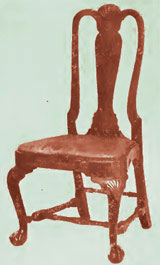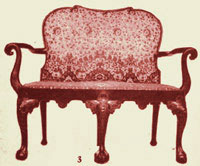Georgian Furniture Style
The Georgian period styles varied widely under the influence of different master cabinet-makers, up to the point that, sometimes, the names of these masters eclipsed those of the kings.
Historically, the Georgian style can be divided as follows:
- The Early Georgian - reign of George I (1714-1727).
- The Transition and the Chippendale style period – George II (1727-1760).
- The Classic Georgian and the decadence of the style - George III (1760-1820).
Some authors consider the Early Georgian Period as covering about forty years, from the accession of the House of Hanover in 1714 to the appearance of Chippendale's "The Gentleman and Cabinet-Maker's Director" in 1754.
Hogarth’s paintings give us a good idea about the look of the furniture of the period, despite the artist’s tendency to ignore the delicate details.

Early Georgian Style Chair with Ball-and-Claw Feet
The Georgian furniture was marked by the decline of walnut and the rise of mahogany. Already used previously under the reign of Queen Anne, mahogany reached the height of its popularity about 1745, in Chippendale's time. During the early Georgian and transition periods, the English furniture tends to drop the purely Dutch characteristics of the Queen Anne period. The backs of chairs became shorter and more varied in outline. The cabriole leg persisted, but the ball-and-claw foot replaced the typical round Dutch foot.
The Georgian style proper really began during Chippendale’s time. Thomas Chippendale began to work towards the end of George I reign. At that time, he was making mainly walnut furniture in what will be named “Transition style”. The “real” Chippendale style emerged around 1735. Gradually, the Dutch elements disappeared, and the English furniture styles will borrow features mainly from the French rococo and Louis XV style, Chinese and Gothic elements, and finally classic and Louis XVI style.
Other important names of the Georgian period were Robert and James Adam, architects and decorators who designed furniture as well and strongly influenced the Georgian style. After a trip to Italy, Robert Adam adopted a style marked by the Roman and Italian classic art. As the late Chippendale period witnessed the emergence of some bad styles, the Adam brothers have the merit of resetting the taste towards the simplicity and grace of the classic. Beside these two characteristics, their style is defined by delicacy, elegance and fine proportions.
As a characteristic of the Adam contribution to Georgian style furniture, the straight leg replaced the cabriole as part of a generally lighter construction, and carving was in low relief, with classic details. Chairs were small and delicate, with backs low and narrow and often oval in shape. The legs were generally straight and slender, but never cabriole. Their later work was rich in inlay of tulip-wood, satinwood, and ebony, and some of it was painted. The inlay was using classic details as well: the urn, the laurel wreath, the oval sunburst, the acanthus leaf, arabesques, ribbon-bands, festoons, and garlands. Furniture made from Adam designs is rare.

Georgian Style Furniture: Settee
Another furniture master was George Hepplewhite, whose work became fashionable between 1765 and 1775. The Hepplewhite furniture style is best known for the shield-back chairs, and the square, tapering legs, often ending in the spade foot. He brought the sideboards to perfection, and created much lighter and graceful four-poster beds.
Thomas Sheraton was the last of the great masters of the Georgian style. He was arguably the most artistic, the master of the desk with secret drawers and inlay. A characteristic of the Sheraton style furniture was the use of certain woods for specific rooms. Both Sheraton and Hepplewhite were decisively influenced by the pioneer work of the Adam brothers.
Georgian style desks, secretaries and clock cases are other pieces of furniture worthy of attention. Tall clocks were made with both square and broken-arch tops, veneered or inlaid. Secretaries and escritoires were first built with ball feet. Later on, the short cabriole with ball-and-claw feet took precedence, followed by the bracket feet, and finally the short, turned legs of the Adam and Sheraton school.
